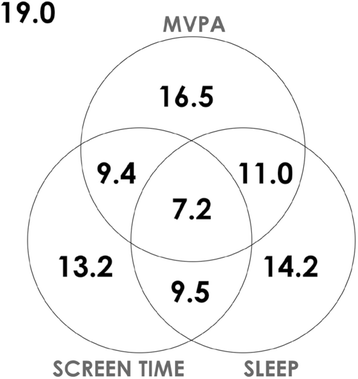Proportion of children meeting recommendations for 24-hour movement guidelines and associations with adiposity in a 12-country study
- PMID: 27887654
- PMCID: PMC5123420
- DOI: 10.1186/s12966-016-0449-8
Proportion of children meeting recommendations for 24-hour movement guidelines and associations with adiposity in a 12-country study
Abstract
Background: The Canadian 24-h movement guidelines were developed with the hope of improving health and future health outcomes in children and youth. The purpose of this study was to evaluate adherence to the 3 recommendations most strongly associated with health outcomes in new 24-h movement guidelines and their relationship with adiposity (obesity and body mass index z-score) across countries participating in the International Study of Childhood Obesity, Lifestyle and the Environment (ISCOLE).
Methods: Cross-sectional results were based on 6128 children aged 9-11 years from the 12 countries of ISCOLE. Sleep duration and moderate-to-vigorous physical activity (MVPA) were assessed using accelerometry. Screen time was measured through self-report. Body weight and height were measured. Body mass index (BMI, kg · m-2) was calculated, and BMI z-scores were computed using age- and sex-specific reference data from the World Health Organization. Obesity was defined as a BMI z-score > +2 SD. Meeting the overall 24-h movement guidelines was defined as: 9 to 11 h/night of sleep, ≤2 h/day of screen time, and at least 60 min/day of MVPA. Age, sex, highest parental education and unhealthy diet pattern score were included as covariates in statistical models. Associations between meeting vs. not meeting each single recommendation (and combinations) with obesity were assessed with odds ratios calculated using generalized linear mixed models. A linear mixed model was used to examine the differences in BMI z-scores between children meeting vs. not meeting the different combinations of recommendations.
Results: The global prevalence of children meeting the overall recommendations (all three behaviors) was 7%, with children from Australia and Canada showing the highest adherence (15%). Children meeting the three recommendations had lower odds ratios for obesity compared to those meeting none of the recommendations (OR = 0.28, 95% CI 0.18-0.45). Compared to not meeting the 24-h movement recommendations either independently or combined, meeting them was significantly associated with a lower BMI z-score. Whenever the MVPA recommendation was included in the analysis the odds ratios for obesity were lower.
Conclusions: For ISCOLE participants meeting these 3 healthy movement recommendations the odds ratios of being obese or having high BMI z-scores were lower. However, only a small percentage of children met all recommendations. Future efforts should aim to find promising ways to increase daily physical activity, reduce screen time, and ensure an adequate night's sleep in children.
Trial registration: The International Study of Childhood Obesity, Lifestyle and the Environment (ISCOLE) was registered at ClinicalTrials.gov (Identifier NCT01722500) (October 29, 2012).
Keywords: Children; Obesity; Physical activity; Prevalence; Recommendations; Screen time; Sleep.
Figures
References
-
- Haskell WL. Evolution of Physical Activity Recommendations. In: Lee I-M, editor. Epidemiologic methods in physical activity studies. Oxford:New York: Oxford University Press; 2009. p. 284.
-
- Chaput JP, Gray CE, Poitras VJ, Carson V, Gruber R, Olds T, Weiss SK, Connor Gorber S, Kho ME, Sampson M, Belanger K, Eryuzlu S, Callender L, Tremblay MS. Systematic review of the relationships between sleep duration and health indicators in school-aged children and youth. Appl Physiol Nutr Metab. 2016;41(6 Suppl 3):S266–S282. doi: 10.1139/apnm-2015-0627. - DOI - PubMed
-
- Tremblay MS, Carson V, Chaput JP, Connor Gorber S, Dinh T, Duggan M, et al. Canadian 24-Hour Movement Guidelines for Children and Youth: An Integration of Physical Activity, Sedentary Behaviour, and Sleep. Appl Physiol Nutr Metab. 2016;41(6 Suppl 3):S311–S327. doi: 10.1139/apnm-2016-0151. - DOI - PubMed
-
- Griffiths LJ, Sera F, Cortina-Borja M, Law C, Ness A, Dezateux C. Objectively measured physical activity and sedentary time: cross-sectional and prospective associations with adiposity in the Millennium Cohort Study. BMJ Open. 2016;6(4):e010366. doi: 10.1136/bmjopen-2015-010366. - DOI - PMC - PubMed
MeSH terms
Associated data
LinkOut - more resources
Full Text Sources
Other Literature Sources
Medical
Miscellaneous


